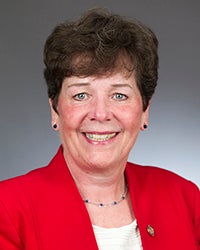Candidate Q&A: Minnesota House of Representatives District 27A
Published 8:32 pm Friday, July 24, 2020
|
Getting your Trinity Audio player ready...
|
By Michael Stoll, Austin Daily Herald
Author’s note: This is a continuation of the Tribune’s Q&A features in which local candidates answer questions about issues that affect Freeborn County and the surrounding area. For this feature, we reached out to Rep. Peggy Bennett (R-27A) and challenger Thomas Martinez (DFL) with questions about rural Minnesota’s workforce shortage. Here are their answers.
What have you heard from district employers in regard to their ability to find qualified employees?

Peggy Bennett
Peggy Bennett: I have made a point to visit many local businesses, schools, hospitals and nursing homes. I value talking to local people because I not only learn about the issues they face, but I also believe that the best ideas and solutions come from ground level, right from our home communities. I have gathered many ideas this way and have been working with colleagues in the Legislature toward solutions.
My discussions with local business people have shown me that all sectors are experiencing workforce shortages — both low and high skilled jobs. This is especially true in the trades industries like electricians, carpenters and welders, and also nurses and health care assistants. COVID issues have exacerbated the problem with many people on unemployment making more money staying at home than if working — and who wouldn’t stay home if that was the case!
I have also found that it is important not to generalize too much — each employer has different issues and needs that relate to that particular industry.
Thomas Martinez: The top three employers in our area are Mayo Clinic, School District 241 and Select Foods. Our top regional employer, Mayo Clinic, recently had to freeze hiring and adjust its staff as a response to the global pandemic, but as of June 24, all their employees have had their pay restored to pre-COVID-19 levels and furloughed workers have been called back to work.
School District 241 staff who need to or can work from home will continue to do so.
This week, I talked with Kathy Niebuhr, executive director of administrative services for District 241, and she said, “Many departments have recently seen an uptick in applicants.”
A single elementary job listing here had 30 job applicants recently, but other departments continue to struggle to find teachers, such as special education, vocational training and family and consumer science.
Lastly, I talked with Don Vonbank, president of the United Food and Commercial Workers, a union that bargains on behalf of Select Foods employees.
He said, “Hiring skilled labor isn’t a real big problem right now.”
Unemployment is nearing 10%. In some factories, seasonal workers can be hard to find because people are not traveling across state lines like before COVID-19.
What do you believe have been contributing factors to the workforce shortage in rural Minnesota?

Thomas Martinez
Bennett: There are multiple contributing factors to the workforce shortage.
First, there is an overall shortage of workers in our entire state. People are having less children and the workforce currently available does not meet the number of retirements that are taking place. This shortage is magnified in the already lesser populated rural areas.
Among the many contributing factors are the child care shortage, an education system that for many years has been focusing on college-bound students and mostly left the trades behind, lack of housing in some areas, broadband deserts and low government reimbursement rates that make it difficult for home and community based services and facilities to be competitive with even McDonald’s workers.
Martinez: I talked with an employment specialist at Express Personnel and I learned they currently have 47 job listings with 33 active members working or looking for work in some capacity. Of that 47, many listings are difficult to fill because they require a special skill, license or degree.
For instance, a typical welding job with a base pay of $13 per hour will require two years experience. That means for a person to fulfill this job requirement, they had to complete high school and go on to a vocational training academy for two years at their own expense, then work for two years as an apprentice for below market value pay while paying back their student loans. Only now are they eligible for a temp agency job for seasonal employment at $13 per hour. Clearly something is wrong with this picture.
We can’t expect our workers to pay thousands of dollars out of pocket for college or trade school and then go on to make starvation wages. If we want a strong workforce in Minnesota, we need to invest in one. Tuition-free public universities will create a workforce that isn’t restrained by debt and provide a means of social mobility for low-income earners.
What steps should the Legislature take to attract more people to help alleviate the workforce shortage?
Bennett: Just as there are multiple factors influencing the workforce shortage in rural Minnesota, the approach to finding solutions will need to be multifaceted as well: education, housing, child care, broadband and more. The state Legislature surely has a part in the solutions, but I believe the real answer lies in collaborative government when appropriate — a mix of local and state government and private and nonprofit sectors.
Did you know that it costs significantly more to build the same home in Minnesota than in any of the states that surround us? Part of the solution for housing involves finding a happy medium with regulations and construction fees at both the state and local level, because they are driving up building costs exponentially. I have worked with my colleagues in the Legislature to produce grants and regulatory reform for child care and other grants, such as those that provide career education, wraparound support services and job skills training in high-demand health care fields to low-income parents, non-native speakers of English and other individuals who struggle with job training. We need to do more programs like this that help bring people who are on government assistance back into the workforce and give families a secure pathway out of poverty. Education is another big key to the workforce shortage, which I have elaborated on below (in question four).
Martinez: School District 241, our area’s second largest employer, has a real need for special licensed professionals.
One program that was designed to alleviate a worker shortage and train the next batch of workers is the work-based learning program in high schools. The idea is that a student who has shown promise in a field, such as agriculture or a trade like carpentry, can work and simultaneously receive course credits. However, licensed work-based learning professionals are nearly impossible to find, in part because only one college in Minnesota offers such a program.
Another sector that is experiencing a workforce shortage is agriculture. The coronavirus has been tough on the agricultural market, but the Trump administration has been tougher on the agricultural workforce. Farmers here in our district depend on seasonal workers, who are often times undocumented, to work in the fields and those workers are not showing up. COVID-19 has made crossing into another country potentially dangerous, but even before the lockdown, the Trump administration has been doing everything possible to stop issuing worker visas, deport DACA recipients and ban whole countries from legally immigrating and working here all together. That needs to stop.
Should schools place more emphasis on preparing students for trade schools or four-year universities?
Bennett: We should not swing back and forth between the trades and colleges like we have in the past. Education must maintain a balance, and students and parents should be the ones in the driver’s seat in deciding what that looks like locally. I have authored an education innovation bill that would start us in that direction where local schools — teachers, administrators and parents — can more easily implement innovative ideas such as the Saturday welding program the Fairmont schools offer, exploring early graduation and more.
We need to create a more seamless connection between K-12 schools and our state colleges, and we need to create pipelines — public private partnerships — where local businesses can work with our schools by providing internships, student worker programs and more. I was part of a group of legislators who helped reform our K-12 teacher licensing requirements — a big step for workforce needs — that will allow professionals in the trades, health care sectors and more to come be a part of educating our students.
Our education system is stuck right now. We need to allow local teachers and parents, who know their children best, to innovate and get the system unstuck so we can meet the needs of today’s students.
Martinez: The answer is both. We need a skilled workforce to rebuild our infrastructure and manufacture our goods, and we need college graduates to fill our schools and hospitals with accredited professionals.
It’s not really a school’s function to decide which vocation a student should have access to, yet schools do have an obligation to prepare their students for the jobs that are going to be available. The real challenge is how to empower students with the resources to find out which path is right for them.
Right now, our schools are finding it difficult to find vocational training teachers for students interested in learning a trade. Colleges are simply not churning out trade school teachers like they are in science, technology, engineering and mathematics.
One obstacle to prosperity for students of color in Minnesota is the achievement gap. What this means is that while resources are available statewide to help students reach their goals, certain demographics routinely have better results. That’s why it’s not enough that our education system and legislators be colorblind; we need to be actively anti-racist to overcome these challenges.
Anything else you would like to add?
Bennett: I think anything we can do as a state to reduce the barriers for our local businesses so that they can flourish and expand is extremely important. Government keeps layering on more and more laws and regulations and never seems to take anything away. We have now reached the point of saturation and it is affecting our ability to develop a robust workforce in rural Minnesota.
Rural Minnesota is a wonderful place to live and raise a family, and the cost of living here is significantly less than the metro areas. Albert Lea and other local communities have started great marketing programs to draw people to this beautiful area. We need strategies to draw metro families, new immigrants and others and let them know what a great place this is to live!
Martinez: I have a friend or family member in nearly every factory, meat packing plant and warehouse in this district. I myself am a working-class man. I am personally invested in the success of our area businesses because everyone I care for depends on them. I have deep ties within our agricultural community through my wife and extended family, and I understand the relationship farmers have with our local food industry.
There is a lot of work to do to get us back on track safely, both in the market and in the field, because not only are we facing a pandemic, but also climate change that impacts our region through unseasonable weather patterns. As a legislator, I will work tirelessly to ensure we have a robust economy, sustainable future and prosperous workforce.



